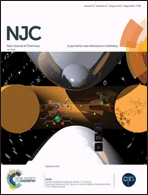Microhydration of a benzoic acid molecule and its dissociation†
Abstract
Proton transfer from a benzoic acid molecule to solvent water molecules occurs only when at least eight water molecules are attached to the benzoic acid, forming a hydrated cluster. Geometrical parameters, bond dipole moments and proton transfer parameters of hydrated clusters of benzoic acid, C6H5COOH·nH2O (n = 1–8), are calculated by applying first principles-based electronic structure theory. While the calculated solvent stabilization energy increases linearly with the increase in the number of solvent water molecules in the hydrated clusters, the interaction energy shows the characteristic features of acid dissociation. The O–H bond dipole moment of benzoic acid also shows the characteristic features of acid dissociation. The free energy of formation of the hydrated acid systems is calculated at different temperatures and pressures, and the hydrated systems are found to be stable at a low temperature and pressure (100 K/1 μTorr). The calculated O–H bond stretching frequency of the acid molecule shows a red-shift with an increase in the number of water molecules in the hydrated clusters. The calculated hydrogen bond energy for breaking the O–H bond of the acid molecule and forming an O–H bond with the solvent water molecule supports the observed fact that at least eight water molecules are required for the dissociation of benzoic acid. The number of water molecules required to dissociate a number of studied acid molecules is observed to be linearly correlated with their pKa values. Thus, using a non-thermodynamic route, one can predict the pKa value of an acid.



 Please wait while we load your content...
Please wait while we load your content...